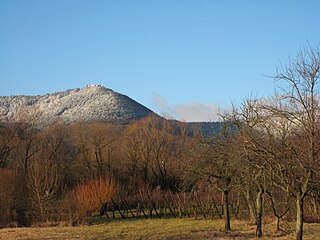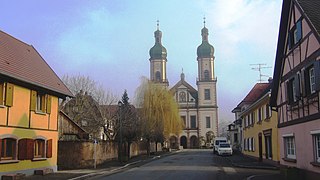
Mont Sainte-Odile is a 764-metre-high peak in the Vosges Mountains in Alsace in France, immediately west of Barr. The mountain is named after Saint Odile. It has a monastery/convent at its top called the Hohenburg Abbey, and is notable also for its stone fortifications called "the Pagan Wall." In 1992, Air Inter Flight 148 crashed near this area.

Mont Sainte-Odile Abbey, also known as Hohenburg Abbey, is a nunnery, situated on Mont Sainte-Odile, one of the most famous peaks of the Vosges mountain range in the French region of Alsace.

Gengenbach Abbey was a Benedictine monastery in Gengenbach in the district of Ortenau, Baden-Württemberg, Germany. It was an Imperial Abbey from the late Carolingian period to 1803.
Gundelina, abbess, she was the third daughter of Duke Adalbert of Alsace and his first wife Gerlinda. She was the younger sister to saints Attala and Eugenia, both nuns and abbesses, and they were all nieces to the famous blind Saint Odilia, the abbess of Hohenburg.

Saint Erhard of Regensburg was bishop of Regensburg in the 7th century. He is identified with an Abbot Erhard of Ebersheimmunster mentioned in a Merovingian diploma of 684. Ancient documents call him also Erard and Herhard.

Buchenbach is a municipality in the south west of the Black Forest in Germany. It is located in the district of Breisgau-Hochschwarzwald in Baden-Württemberg. It is made up of four communities, the main town of Buchenbach and the villages of Falkensteig, Unteribental and Wagensteig. The current municipality was formed by the merger of the former entities of Buchenbach and Falkensteig on 1 December 1971, with Wagensteig being joined to them on 1 August 1973 and Unteribental on 1 January 1975.

Adalrich, also known as Eticho, was the Duke of Alsace, the founder of the family of the Etichonids and of the Habsburg, and an important and influential figure in the power politic of late-seventh-century Austrasia.
Adalbert was the Duke of Alsace beginning after 683 and probably until his death. He was the second duke of the family of the Etichonids and the first to inherit the duchy from his father.
The Etichonids were an important noble family, probably of Frankish-Burgundian origin, who ruled the Duchy of Alsace in the Early Middle Ages. The dynasty is named for Eticho, who ruled from 673 to 690.

The Niedermünster or Niedermünster Abbey, Regensburg, was a house of canonesses (Frauenstift) in Regensburg, Bavaria, Germany. At the height of its power it was one of the wealthiest and most influential in Bavaria. The church is still in use as the parish church of Regensburg Cathedral.
Hidulf was an abbot, founder of Moyenmoutier Abbey, and reputed bishop of Trier. He is a Catholic and Orthodox saint. His feast day is 11 July.

Saint Odilia is a Saint venerated in the Roman Catholic Church, although according to the current liturgical calendar, her feast day is not officially commemorated. She is a patroness of good eyesight.

Ebersmunster Abbey was a Benedictine abbey in Ebersmunster in Alsace, Bas-Rhin, France. The Baroque abbey church of St Maurice survives.

December 12 - Eastern Orthodox liturgical calendar - December 14

St. Odile is a forest sanctuary in Freiburg's suburb Waldsee. It is located at a height of 480 m in a forest clearing in the upper St. Odile ravine in the municipal forest of Freiburg at the southern slope of the Roßkopf at a distance of approximately 750 m from St. Wendelin.

The Musbachtal is a small 2.6 km long steep and narrow carved valley with a creek at the bottom.

Niedermunster Abbey, situated at the foot of Mount Saint Odile at an altitude of 511 metres, was founded around 700 A.D. to cater for the overflow of pilgrims to the Saint Odile Abbey, formerly known as the Hohenbourg.

Tennenbach Abbey was a Cistercian abbey in what is now the district of Freiamt in the town of Emmendingen, Baden-Württemberg, Germany. It was originally named Porta Coeli.

The Abbey of St. Märgen is a former Augustinian canons monastery in St. Märgen in the Black Forest in Germany, which was founded around 1118 under the name Cella Sanctae Mariae. The German form of the name, Maria-Zell, changed over the centuries through Marienzell, Sante Merien and St. Mergen to the present name of the abbey and village, St. Märgen. The Baroque abbey church of St. Mary of the Assumption is today the Roman Catholic parish church of St. Märgen and one of the most important Marian pilgrimage churches in the Archdiocese of Freiburg.

Eugénie of Alsace, was the second abbess of the Hohenburg Abbey, in Alsace, France, from 721 to 735, and she was later made a Roman Catholic saint. She was a niece of Saint Odile and sister of Saint Attalus. Saint Eugénie's feast day is celebrated on 16 September, which was the day she died of natural causes in 735 in Hohenburg.





















